Elephants in Thailand
The elephant has been an important figure in Thai society and a significant symbol for many centuries. It has a considerable amount of influences and impact on the Thai cultural system and the whole nation, and the Thai elephant (Thai: ช้างไทย, Chang Thai) is an official national symbol of Thailand. The type of elephant that can be found in Thailand are the Indian elephant (Elephas maximus indicus), a subspecies of the Asian elephant.
Habitat
Thai elephants have slight differences from other races of Indian elephants; they are smaller, have shorter front legs, and a thicker body than their Indian counterparts.[1] They are herbivores that consume ripe bananas and tender leaves, bamboo, tree bark and fruits.[2] Because of their diet, their natural habitats are located in tropical forests which are found in the northern and western part of Thailand. Mae Hong Son, Chumpon, and the border near Burma (Huai Kha Khaeng Wildlife Sanctuary, Erawan Falls National Park, etc.), Petchabun range, Dangrek Range, and Peninsular Thailand (Ranong, and Trang).[3]
Thailand used to contain 90% of green canopy regions; however, after the interference by the illegal logging industry, it now contains less. This has a negative impact on the habitat of the Thai elephants, resulting in the plummeting numbers of the animal, placing them on the endangered species list.[4]
Relationship with people
.jpg)
In Thai society elephants have played a substantial role in manual labour, war combatants, royal symbol, and the tourism industry. For thousands of years, elephants were captured and trained to be a form of transportation and heavy labour. When logging in Thailand was still legal, they hauled heavy logs through the terrains of the forest, which in turn gave many Thai people jobs. In recorded Thai history, during the reign of King Ramkhamhaeng the Great of Sukhothai, Thais used to hunt and trade elephants.[5]
Known for their strength and intelligence, elephants were used as war elephants since the days of Alexander the Great.[6] They were referred to as a warm-blooded armoured-tank. Each elephant has a distinctive personality, mostly male elephants that are aggressive yet tameable were selected to be war elephants. They were trained with lightly pricked spear on their skin in order for them to move forward. The training was conducted in a loud environment of shouting and drum sounds to accustom them to the real warfare.
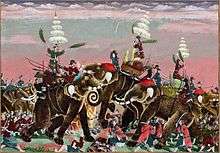
Thai royals and elephants have established a relationship for thousands of years. The first recorded Thai elephant was in the stone inscription of King Ramkhamhaeng the Great of Sukhothai. In this inscription he mentioned himself being nineteen and said his elephant, Bekhpon, advanced their attack on Khun Sam Chon to protect his father, while his father’s soldiers fled in fear. Chao Praya Prabhongsawadee was the elephant of King Naresuan of Thailand that came out triumphant in the elephant duel (ยุทธหัตถี) between the King of Burma and King Naresuan during the war with the Burmese. For a very long time, it was a law that when a white elephant was found and a tradition that when an elephant with good build was found, it was to be presented as property to the King of Thailand. Thai’s sacred and royal symbol was the white elephant (Chang Pueak or Chang Samkan). They are not albinos but are genetically different. White elephants are not white, they are a dusky pinkish grey. Phra Savet Adulyadej Pahon is a white elephant that belongs to Thailand’s King Bhumibol Adulyadej.
Since the logging industry became illegal, elephants owners (mahouts) have to find other ways to feed their elephants, most of them turning to the entertainment industry and tourism.[7] Most mahouts took their elephants to Bangkok, roaming the streets with baskets of fruits for the tourists to buy and feed the animal. Elephants now have to beg for food and perform tricks in exchange for money. This however lowers the status of elephants from having a high cultural importance to mere commodities. On June 17, 2010, the laws were passed for the elephant protection, making these acts illegal.[8] Elephants in the entertainment industry are trained to follow over forty commands; they can kick soccer balls, participate in talent shows, and use their trunks to paint and lift objects and sometimes people.
Cultural Significance
Historically, elephants in Thailand are considered to be very important culturally. There are many elephant’s references to art works, literature and national emblems. Since Thailand is a Buddhist country, elephants are portrayed as sacred animals from their special symbolism in the practice of Buddhism. Many art works in Thai royal palaces and temples have drawings of elephants on the paintings on the walls. In 1917, Thailand’s official flag was a white elephant in the middle of the scarlet background. White elephants in Thai society also represent wealth and power because of their past association with the Thai royals. The royal Thai navy flag also bears the symbol of white elephant. Many provinces in Thailand used to have elephants as part of their official emblems as well. [9]
Elephant in Thailand's official provincial seals
| Provincial seal | Province in Thailand | Description |
|---|---|---|
| Current province | ||
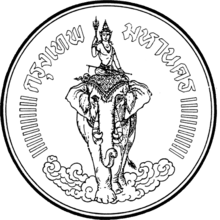 |
Bangkok | Indra rides Erawan elephant |
 |
Chiang Rai Province | White elephant, cloud, and Naga border |
 |
Chiang Mai Province | White elephant standing in glass palace |
 |
Tak Province | King Naresuan poured holy water over the elephant's neck |
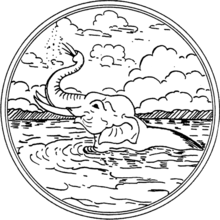 |
Mae Hong Son Province | Elephant plays in the water |
 |
Nakhon Nayok Province | Elephant with ear of rice in its trunk |
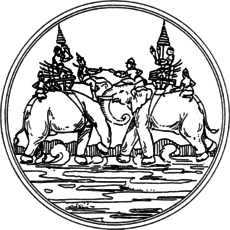 |
Suphan Buri Province | Elephant duel between King Naresuan and Mingyi Swa of Burma at Nhong-sarai sub-district in 1592 |
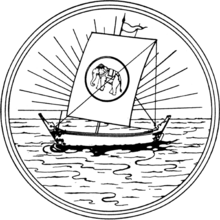 |
Narathiwat Province | A sailboat's flag bear the symbol of the elephant (Phra sri nara raja kirinee) wearing elephant ornament |
| Former province | ||
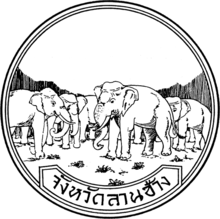 |
Lan Chang Province | Herd of elephant standing in a large field |
Preservation and conflict
The illegal logging industry destroyed a lot of major natural habitats, and the tourism industry treated elephants poorly. This resulted in a shocking drop in the number of elephants in Thailand. A lot of organizations were established to better the lives of the elephants. There are many local conservation centres in Thailand which are located mostly where the animals are found the most. Thai Elephant Conservation Center is the only organization that is government owned which is located in Lampang, a province in northern Thailand.[10] There are many more private organizations contributing to preserving this endangered species as well. These organizations generate revenue by letting people experience elephants in their natural state. They also have a schedule of elephant shows which are not harmful or too tiring for the elephants.[11]
Thailand’s tourism industry took baby elephants from when they are four years old. Their “cuteness factor” is exploited for tourists to enjoy and they are disposed of when they become older.[12] These baby elephants however were taken away from their mother from a very young age. They lack the nutrients to stay healthy and most of them died. Elephant torturing is still present in Thailand. They are forced to work extra hours in bad living conditions and with bad medical care.[13] Ivory trading is illegal in Thailand, however there are still many underground movements that hunt elephants for their precious ivory.
See also
References
- ↑ "Facts about Elephants." Elephant Nature Park. Web. 2 Dec. 2015. <http://www.elephantnaturepark.org/about/facts-about-elephants/>.
- ↑ Komar, Vitaly, and Aleksandr Melamid. When Elephants Paint: The Quest of Two Russian Artists to save the Elephants of Thailand. New York: Perennial, 2000. Print.
- ↑ Sukumar, R. The Asian Elephant: Ecology and Management. Cambridge: Cambridge UP, 1989. Print.
- ↑ Buckly, Dana, Vasinthon Buranasuksri, Tamchit Chawalsantati, Sean Maquire, Narumon Patanapaiboon, Natapol Techotreeratanakul, and Kimberly Woodward. Thai Elephants: An Evaluative Study of Contemporary Living Conditions for the Betterment of Asian Elephants in Thai Culture. Thesis. Chulalongkorn University, 2011. N.p.: n.p., n.d. Print.
- ↑ Warren, William, and Ping Amranand. The Elephant in Thai Life & Legend. Bangkok: Monsoon Editions, 1998. Print.
- ↑ "Elephants at War from Ancient Times to the 20th Century." About.com Education. Web. 14 Nov. 2015. <http://asianhistory.about.com/od/warsinasia/ss/War-Elephants-in-Asian-History.htm>.
- ↑ "The Role of Tourism in Elephant Welfare in Northern Thailand." Journal of Tourism X.2. Print.
- ↑ Web. 2 Dec. 2015. <http://203.155.220.110/changyim/canon.php>.
- ↑ "The Thai Elephant Symbol of Nation." The Thai Elephant Symbol of Nation. Web. 14 Nov. 2015. <http://www.chiangmai-chiangrai.com/elephants_thai.html>.
- ↑ Web. 14 Nov. 2015. <http://www.thailandelephant.org/en/thaielephant.html>.
- ↑ "How to Interact Ethically with Elephants in Thailand - Lonely Planet." Lonely Planet. 10 Nov. 2014. Web. 14 Nov. 2015. <http://www.lonelyplanet.com/thailand/travel-tips-and-articles/how-to-interact-ethically-with-elephants-in-thailand>.
- ↑ "The Shocking Secrets Behind Thailand’s Elephant Tourism Industry (VIDEO)." One Green Planet. Web. 14 Nov. 2015. <http://www.onegreenplanet.org/animalsandnature/secrets-of-thailands-elephant-tourism-industry-video/>.
- ↑ "Why You Shouldn't Ride Elephants In Thailand • Expert Vagabond." Expert Vagabond RSS. 17 Sept. 2013. Web. 14 Nov. 2015. <http://expertvagabond.com/elephants-in-thailand/>.